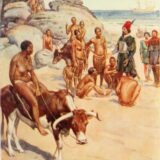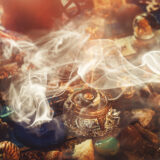Table of Contents
Mushrooms That Are Psychoactive

About Psychoactive Fungi and Which Mushrooms Are Psychoactive
The fungi and mushrooms of the world look much different than other types of plants. They are often bulbous and a little ugly. While trees, bushes, reeds, and even cacti can sometimes spawn beautiful flowers and/or colors, fungi are usually a little disgusting looking….almost ‘unsanitary.’ Regardless, they have their place in life like anything else, and many of the fungi and mushroom out there are psychoactive. Due to their psychoactive properties, these fungi are usually regarded as sacred by many religions around the world. They have been used by shaman, medicine men, tribes and cultures and for purposes of all sorts.
The History of Psychoactive Mushrooms
There are many ancient texts which have taken note of psychoactive fungi for the use of one purpose or another. Most of the ancient references to these types of fungi, are with the general sense that they are sacred and meaningful to the gods. Some cultures believe that they are actual food or sustenance from the gods. Other cultures believe that they were placed on earth in order for shaman and other religious believers to be able to communicate with the gods or spirit world. There are within records about mushrooms dating all the way back nearly 500 years before Christ.
Despite the fact that psychoactive mushrooms and fungi may have been discussed in literature dating back thousands of years ago, it was only recently (1500s) that any mushrooms were written about for their inebriating effects. Most of the documentation revolving around intoxicating or psychedelic mushrooms tend to revolve around religious or ceremonial use. There are many rituals in cultures around the world which employee mushrooms for their hallucinogen and vision inducing properties. They have been used for divination, prophecy, communication with otherworldly beings, self-exploration, cleansing of the soul, balancing the body’s chemistry, medicine and healing, and many other things.
Even though fungi may not have been referenced in a well-documented fashion in regards to being used in a hallucinogenic sense before the 16th century, there are rock paintings that suggest psychedelic effects from mushrooms which date back to the Neolithic period. In fact, there is even one theory that the Psilocybe cubensis species were directly responsible for primate evolution (specifically that the mushrooms were the catalyst). While all psychedelic or psychoactive mushrooms may have played some role in the developing of many cultures around the world, some of them have been more important than others. The mushrooms which contain psilocybin and psilocin have had the most significant impact on cultures throughout the world (and throughout history).
Full List of Psychoactive Fungi
Some of the mushrooms out there are more valuable and/or useful than others. Here is a list of all of the psychoactive fungi known to man.
Amanita muscaria
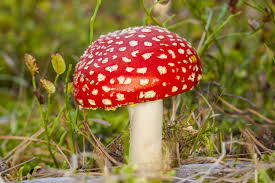
Growing in North America (including Mexico), Central America, Asia, Europe and Australia
These mushrooms are typically known as Fly Agaric. They are well documented throughout history to contain psychoactive effects and be involved in religious rituals. They are regularly associated with shamanism and have been used in a variety of shamanistic rituals. They have many religious purposes and are sacred to many cultures. They are used to enter a trance, or ‘state of enlightenment.’
Amanita pantherina
Growing abundantly throughout Russia and Asia
These are closely related to Amanita muscaria. It is also known as a Panther Cap and well known to be a recreational ‘party drug’ for its strong hallucinogenic effects.
Balansia cyperi
Abundant throughout Central and South America
Balansia is also known as Cyprus Grass Fungus and literally grows on grasses as a parasite. There are ergot alkaloids found in Cyprus responsible for the psychoactive effects.
Claviceps paspali
Growing abundantly throughout India and Asia; Also found in North America and the Mediterranean
The Ergot alkaloids present in this infesting fungus are found throughout a number of grasses all around the world. The alkaloids are most important are lysergic acid amide (LSA) and lysergic acid hydroxyethylamide. It is probably the hallucinogenic ingredient in the well known Eleusinian initiatory drink, “Kykeon.”
Claviceps purpurea
Grows Worldwide
This fungus is most commonly known simply as “Ergot” and infects many types of reeds and grasses (such as very commonly, Rye). Ergot is a parasite, but it is full of alkaloids which provide numerous psychoactive effects and uses.
Conocybe spp.

Found growing in North America and Europe
The Conocybe, also known as “Cone Caps” produce tiny fruiting bodies that contain high quantities of psilocybin. Some cultures refer to them as the mushrooms of great knowledge and there are many cults and religions alike which regard them as sacred.
Copelandia spp.
North America, Mexico
Also known as “Ink Caps,” these mushrooms contain psilocybin and are well known for their psychoactive properties.
Galerina steglichii
Germany
Interestingly enough these mushrooms only started recently appearing in the 1990s and only in Germany. They are tiny and have a blue like color when pressed upon. Also known as “Steglich’s Galerina,” they contain psilocybin, psilocin and baeocystin.
Caution: Some of these species can be poisonous and fatal!
Gymnopilus spp.
North America
These large, yellow-to-golden fanned-looking mushrooms grow atop dead wood or humid soils. They are very common throughout the woodlands and many species contain psilocybin.
Inocybe spp.
Europe
Inocybe Mushrooms can be small or medium in size, have long stems and tiny convex caps. They are a golden or toasted-brown color and are feared in folklore due to being poisonous. There are more than 160 different species, most of which contain psilocybin.
Panaeolus cyanescens
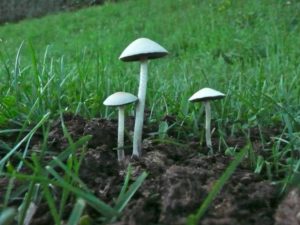
Asia, Australia, and Europe
Also known as “Jambur mushrooms,” they take on a light blue or cyan tint on a small “opened umbrella-like” shaped caps. They are well-known to be intoxicating and contain psilocybin in the fruiting bodies.
Panaeolus subbalteatus
Europe and Asia
Also called “Dark-rimmed Mottlegill” mushrooms, they grow in fertilized fields of the subtropics and tropics. They contain psilocybin and baeocystin. They also contain serotonin and 5-hydroxytryptophan.
Panaeolus spp.
North America, Central and South America, Africa and Europe
The Panaeolus Mushrooms belong to the Ink Cap family and can grow medium to large in size. Depending upon the region of the world, the mushroom may or may not possess quantities of psilocybin, psilocin, or other psychoactive substances; but almost all of the species contain a little of at least one psychoactive substance.
Pluteus spp.
Native to Europe
The Pluteus Mushrooms are small to medium in size with convex caps that can open almost 180 degrees, or be closed by nearly 45 degrees. They thrive on decaying wood and during the summertime and often have a blue hue. They are well-known for their psilocybin and hallucinogenic properties.
Polyporus mysticus
Abundant in the Alps, Europe, Central and South America, and Asia (especially mentioned in Chinese texts)
The Polypore species are numerous in quantities and types, and have a long history of ceremonial use. They may have been used earlier than 5300 years ago, as is evident of their involvement in a ceremonial burying ritual of a recently discovered ancient mummy known as “Otzi” of the Alps. History tells a tale of Polyporus mushrooms being almost a prehistoric “LSD” like drug used by shaman around the world.
Psilocybe azurescens
Grows in North America, Central America, South America, Asia, the Middle East, Africa and Europe
Indigo Psilocybe mushrooms are found all around the world, and have rich religious and sacred value in a great number of cultures. There are psilocybin, psilocin and baeocystin present in all of the Indigo psilocybe mushrooms, making them strongly hallucinogenic and popular for recreational use. They have a great deal of religious and cultural significance in ancient Egypt.
Psilocybe (Stropharia) cubensis
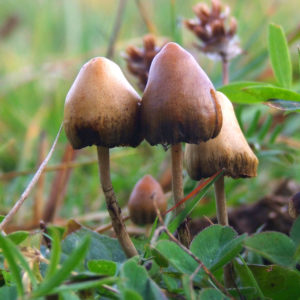
Growing in Asia, Australia, North America (especially Mexico), and in Central and South America; As well as on many islands
Psilocybe cubensis are typically the mushroom people are referring to when they say “Magic Mushrooms.” This mushroom is also known as a Golden Cap or a Divine Dung Mushroom. It is most abundant where there is fresh cow or horse dung present…or in manure-fertilized soil. There are beliefs that the mushrooms may have contributed to the drug known as Soma. Psilocybin, psilocin and baeocystin are present as active constituents in the caps and stems (more in the caps than the stems).
Psilocybe cyanescens
Found in Grassy Soils of the Pacific Northwest; North America and Europe
These mushrooms are powerfully hallucinogenic containing psilocybin and psilocin alike. There are also smaller amounts of baeocystin present.
Psilocybe mexicana
Growing in Mexico and Guatemala exclusively
These mushrooms are also known as Mexican Magic Mushrooms and Teonanacatl. They have strong ethnohistorical value in the area and have played huge parts in many religious ceremonies for thousands of years (especially before the Spaniards arrived on conquest). They are used by the Mayans, the Aztec, and an array of other cultures and tribes. Psilocybin and psilocin have been found in generous concentrations in these mushrooms.
Psilocybe semilanceata
Found Worldwide; Most abundant in Europe and North America
Known as “Liberty Caps,” these mushrooms are one of the most common psychedelic mushrooms of Europe. They are especially well known in Italy (even today), but have been associated with Neolithic rock paintings, suggesting their psychedelic use stretches far back. They thrive upon decaying dung and fertilized soils. They are used for many psychoactive effects, including lucid dreaming and vision dreaming. Liberty Caps contain psilocybin, psilocin and baeocystin.
Psilocybe spp.
All Around the World (Cosmopolitan)
Technically, there are 18 different sections of mushrooms in the Psilocybe genus. This included more than 150 species. They grow all over and come in all different shapes, sizes, colors and cap formations. They grow in different arrangements, and upon different terrains. They contain varying amounts of psychoactive substances. And they have been used in a variety of religious, ceremonial, medicinal, shamanic, recreational and other ways.
Last Notes About Psychoactive Fungi
Almost all regions around the world have at least one type of psychoactive or even hallucinogenic mushroom native to the area. In fact, it can be very common to find many psychoactive fungi within one single region. Whether used for religious purposes, medicinal purposes, or recreational purposes, many fungi around the world have been used for their psychoactive effects for thousands of years…and the effects of many more have likely yet to be discovered!


